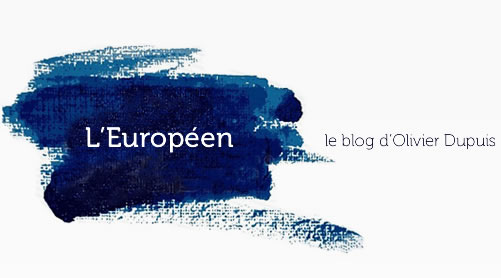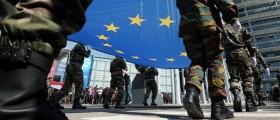Le HuffingtonPost.fr, March 19, 2015, InformNapalm (fr), March 19, 2015, InformNapalm (en), March 19, 2015, InformNapalm (es), March 22, 2015, European Sotnia, March 22, 2015, Strade, March 24, 2015
Beginning with the observation that « with regards to foreign policy, we (Europeans) do not seem to be taken seriously » 1 Jean-Claude Juncker has made it clear in a recent interview with Germany’s Welt am Sonntag, that the European Union must have a common army. According to the President of the European Commission, the mere decision to equip itself with such an instrument would allow the EU to « send a clear signal to Russia that we (Europeans) are serious about defending European values » and would put the EU in a position to react « credibly » to threats to peace in a Member State or in a State bordering the Union. The words he used are of paramount importance. Juncker does not refer to a single European army that would replace the national armies; he is talking about a common European army. At no time does he say that all Member States would have to participate in such an undertaking. And finally, he makes it clear that a common army would not represent a “challenge” to NATO.
If we take these three crucial elements (a common and not a single European army, voluntary participation and compatibility with NATO) and add to them the impossibility over time of protecting the technological and military knowledge of the armies and industries of the different Member States, even the largest of them, due to the narrowness of national markets, we are able to imagine a scenario of what this Common European Army would look like, as well as to envision its relationship to national armies on the one hand, and to NATO on the other.
A solid legal basis
According to Articles 42 § 6 and 46 § 1, 2 and 3 of the Treaty on European Union (TEU), participating States could opt for Permanent Structured Cooperation (PESCO) with the goal of creating a common European army. In the politically risky event that a Member State of the EU chose to avail itself of its right to veto this initiative, the participating States could decide in the short term to pursue their objective outside the Treaty, much as was the case when States orchestrated the free movement of persons among participating countries under the auspices of the Schengen Agreement.
To what end?
The first aim of this Common Army would be to protect the security and territorial integrity of the participating Member States. The Army would also be authorized to conduct humanitarian missions, peace keeping and peace making operations, and to evacuate citizens of the EU.
In order to assure permanent deployment, the core of the Common European Army would be composed of three air and naval groups employing, most obviously, the two Mistrals that had initially been earmarked for Russia, as well as of three rapid-intervention teams.
A strictly « EU » (communautaire) political and institutional organization
The President of the Commission would have political responsibility of the European Army, while a Commissioner, appointed by the President of the Commission, would be charged with the organization and functioning for the Common European Army.
Any organizational decision would have to be ratified by both the Foreign Affairs Council and the European Parliament. Measures would be considered adopted after gaining the approval of at least 55% of the States participating in Permanent Structured Cooperation, and of 65% of the population of those States, as well as of the majority of MEPs of those States.
The President of the Commission will submit all decisions to deploy the European Army to a European High Council for Security 2, composed of the Heads of State and government of the participating countries. Decisions would be ratified by a qualified majority.
European soldiers
The civilian and military personnel of the Common European Army will have the status of EU employees. The salaries of civilian and military personnel will be calculated on the basis of an average of the five highest wage levels for equivalent skills and responsibilities in countries participating in PESCO. As with the European Commission, the personnel for the Common European Army will be divided proportionally among the participating States according to their respective populations.
The Common European Army will have its own general staff whose headquarters will be based in Brussels. Members of the general staff will be appointed by the President of the European Commission upon the recommendation of the Commissioner in charge of PESCO.
The working language of the Army will be English. Officers, non-commissioned officers, soldiers and civilian personnel will take an oath before the President of the Commission and / or the Commissioner in charge of PESCO.
The Common European Army will have an independent command hierarchy. It will independently manage its own military schools (naval, ground, air force). It will have its own intelligence services (information and counterintelligence). Measures will be put in place to ensure close collaboration between these services and those of the Member States participating in PESCO.
The Common European Army’s naval, ground and air force bases will be located according to strategic criteria while also taking into account differences among participating countries with respect to the state of their arms industry. Accordingly, the first naval bases will be set up in Poland, Bulgaria and Portugal, and the ground bases will be set up in Romania, Spain and the Baltic countries.
Each participating State’s initial contribution will be 0.30% of its GDP. This contribution could be included in the military expenditures of NATO members.
Full compatibility with NATO
The Common Army of the Union will have the special status of a “reserve force” within NATO. It would only become part of NATO forces under direct authority of the allied High Command in the case of recourse to article 5 (threat towards the security of one or several NATO Member States). In all other circumstances, it will serve only the citizens and governments of countries involved in PESCO.
Measures will be put in place to ensure close collaboration between the Common European Army and the armies of PESCO States. When necessary, the Common Army will offer joint operations with national armies of participating States.
An incentive to bolster cooperation in the military-industrial sector
Taking into account both the investments made in the military-industrial sector over the last seventy years by some Member States and the willingness of other Member States to increase their future investments in this sector, the States participating in PESCO will be committed to fostering mergers among firms in the sector. For example, the Member States will prioritize the purchase of the Common European Army’s equipment from groups representing firms from several participating countries. In particular Member States will work to create a large military aviation conglomerate around the Airbus and Dassault groups that will welcome the participation of other Member States (or of companies of these States). Similarly, in the area of naval construction, firms will be encouraged to merge their military branches into three or four common subsidiaries.
A remedy for Europe’s disintegration
In Europe, many people are still not prepared to recognize the strategic paradigm shift that the annexation of Crimea and the invasion and occupation of Donbass by Russian and pro-Russian forces have created. Within the European Union, a majority of States still believes that it is possible to return to the status quo with the current Russian regime. Some states, including Spain, are even openly demanding that we drop all sanctions. Currently only a minority of States – some on the front line – have a clear understanding of how serious the repercussions from the situation in Ukraine will be not only for Ukraine, but for the present and future cohesiveness of the entire European Union. Add to that the tragedies in Syria, Iraq and Libya, and the differing perceptions of these events within EU countries, and it becomes obvious that we urgently need to find ways to “force” States to think about security not as a matter solely of national concern, but as both a national and European consideration.
In this context, one of the many virtues of the initiative that the President of the European Commission has taken is undeniably to propose to the EU a means that, by its very existence, immediately allows the EU to take on greater cohesiveness in these turbulent times.
(Translation: Anis Memon)








Pingback: A Common European Army: instructions for use - InformNapalm.org (English)
Pingback: Ejército Común Europeo: instrucciones de uso - InformNapalm.org (Español)
Pingback: Ejército Común Europeo: instrucciones de uso | Tol.News